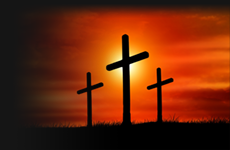
Bible Art

Supper of Emmaus
Artist: Caravaggio
1601
Painting
Mannerism gave way to Baroque art which is full of dark backgrounds, deep colors, dramatic light and sharp shadows. All of these characteristics can be seen in Caravaggio’s Supper of Emmaus. It depicts the Gospel story of the resurrected Jesus's appearance in Emmaus. The image depicts the moment that Jesus breaks the bread and the Emmaus travelers recognize Him as the resurrected Messiah (Luke 24:13–35). "Then the two from Emmaus told their story of how Jesus had appeared to them as they were walking along the road, and how they had recognized him as he was breaking the bread."
The painting is oil on canvas,measures 141 cm × 196.2 cm (56 in × 77.2 in) and is in The National Gallery in London.
-tower-of-babel.jpg)
The (Great) Tower of Babel
Artist: Pieter Bruegel the Elder
1563
Painting
The story of the Tower of Babel is told in the book of Genesis, chapter 11, verses 1-9. Babel, a city in the land of Shinar, was the first city built by the descendants of Noah after the Great Flood. Their leader, Nimrod, planned to build a tower of bricks and lime that would reach to the heavens. He was conceited and acted against God’s will. God condemned these ambitious, vain plans and confounded the construction. He changed what was once a nation with one language into numerous peoples that were spread across the face of the earth, each speaking a different language. From then on the different peoples lived in a ‘confusion of tongues’.
The story of the Tower of Babel contains a universal message. The biblical construction of the tower symbolises man’s ambition to attain the highest possible goal. It also symbolises the eternal struggle between mankind’s ambition and his hubris, which is mercilessly punished by God. Mankind blindly trusts his own capabilities and the unbridled possibilities of technology. God’s punishment of this arrogance symbolises man’s insignificance and mortality. Bruegel too is somewhat vain in his attempt to paint the tower that was designed to reach to the heavens, thus reinforcing the message of the story. In Bruegel’s depiction of ‘The Tower of Babel’, God’s punishment has not yet been enacted: the bricks are still being carried up the tower and the harbour below is a hive of activity.
Bruegel made ‘The Tower of Babel’ around 1560 when he was approximately 35 years old. He visited Rome and took inspiration from the Colosseum for the tower’s architecture. Towards the top of the building, however, the arches take on the more pointed form found in Gothic cathedrals.
The Tower of Babel was a popular theme in the 16th century, especially in Antwerp, where Bruegel worked. Antwerp was a busy harbour city, visited by ships from all over the world and numerous languages could be heard on its streets. This made the Old Testament story of the confusion of tongues all the more relevant. Bruegel painted two other versions of the ‘Tower of Babel’. One is in the Kunsthistorisch Museum in Vienna. The painting is smaller than the version in Museum Boijmans Van Beuningen and the construction of the tower is depicted at an earlier stage. The other version is a miniature painted on a piece of ivory. The whereabouts of the latter work are unknown.
1 2 3 4 5 6 7 8 9 10 11 12 13 14 15 16 17 18 19 20 21 22 23 24 25 26 27 28 29 30 31 32 33 34 35 36 37 38 39 40 41 42 43 44 45 46 47 48 49 50 51 52 53 54 55 56 57 58 59 60 61 62 63 64 65 66 67 68 69 70 71 72 73 74 75 76 77 78 79 80 81 82 83 84 85 86 87 88 89 90 91 92 93 94 95 96 97 98 99 100 101 102 103 104 105 106 107 108 109 110 111 112 113 114 115 116 117 118 119 120 121 122 123 124 125 126 127 128 129 130 131 132 133 134 135 136 137 138 139 140 141 142 143 144 145 146 147 148 149 150 151 152 153 154 155 156 157 158 159 160 161 162 163 164 165 166 167 168 169 170 171 172 173 174 175 176 177 178 179 180 181 182 183 184 185 186 187 188 189 190 191 192 193 194 195 196 197 198 199 200 201 202 203 204 205 206 207 208 209 210 211 212 213 214 215 216 217 218 219 220 221 222 223 224 225 226 227 228 229 230 231 232 233 234 235 236 237 238 239 240 241 242 243 244 245 246 247 248 249 250 251 252 253 254 255 256 257 258 259 260 261 262 263 264 265 266 267 268 269 270 271 272 273 274 275 276 277 278 279 280 281 282 283 284 285 286 287
